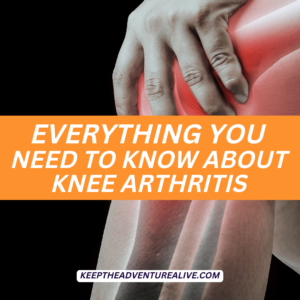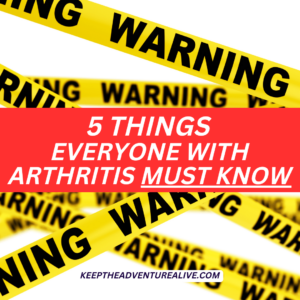When looking at the connection between arthritis pain and colder weather, cold weather increases thickness (also known as the viscosity) of the fluid in your joints and can make them feel stiffer, along with increased sensitivity to pain. During colder temperatures, you also tend to decrease our activity levels which can contribute to pain and stiffness too. Colder, damp temperatures can affect arthritis pain but don’t worry, you can be prepared! Thriving through winter adventures is possible even with colder temperatures and arthritis pain.
I was recently talking with a family member about their hip and low back arthritis pain. They had mentioned that when it gets colder outside, they start to notice more pain. Is arthritis pain and colder weather connected? I decided to do some research on this connection.
Arthritis pain and colder weather do seem to be connected. Many times colder weather months can be a little more difficult for people with arthritis because your joints become stiffer and movement seems to be more difficult. There are a few reasons why this can happen, let’s take a look:
- There is a fluid in your joints in between your bones that helps them move more smoothly called synovial fluid. In the colder temperatures, it has been shown that this fluid increases in thickness and doesn’t flow as smoothly. When this happens, our joints become stiffer and seem much more difficult to move. This fluid can also make our joints more sensitive to pain because there is more friction between the joints. Think of water vs molasses.
- In the winter months you may decrease your activity levels. In the colder temperatures, you may be less motivated to go for a walk or spend time outdoors. You may choose to spend time at home, covered up with a blanket, and drinking a nice warm drink! Physical activity is great for your cartilage as it helps to increase blood flow which increases nutrients traveling to your cartilage. With limited activity, your cartilage becomes more brittle and less cushioned making your joints more sensitive to pain.
- Colder weather brings holiday months. These holiday months typically come with social gatherings and potentially overindulging in treats. These treats are typically higher in high fructose corn syrup, saturated and trans fats, and carbohydrates. These can typically increase inflammation which can lead to more irritation inside the joint.
What you can do for arthritis pain and colder weather
Colder weather doesn’t always have to wreak havoc on your joints. Especially if you live in an area that has a longer or colder winter.
Here in Utah, winter is one of the locals favorite seasons and after moving here I see why! But, how do most people with osteoarthritis out here deal with the winter temperatures?
Most I’ve met had no idea there were things they could do to help the increased joint pain, so they usually just try to “suffer through it”. But that doesn’t have to be the case!
Watch the three tips in this video below and you can also read underneath the video!
Here are three tips to make it through the winter while taking control of your pain!
- Warm-up your joints! You can do this in a variety of ways to keep your joints warm and less painful. This could include using heating pads, compression sleeves (my favorite compression sleeves can be found here) or gloves, heated socks/slippers, heated mittens, or extra blankets in the morning. Joint stiffness decreases with increasing heat because it limits the friction as it is decreasing the thickness of the fluid in your joints. Especially in the morning, having a plan can limit the stiffness you feel and decrease your pain.
- Plan physical activity. Switching to finding an exercise routine you like that you can do indoors (stationary bike, elliptical, treadmill, strength training, kickboxing, sports, etc) or try something new outdoors (hiking, cross country skiing, snow shoeing, etc)! You can also try to add in small movement breaks during the day every 1-2 hours to avoid staying in one position for too long. You have to find ways to keep moving so we can keep our joints happy, even with colder temperatures. The link to my free 4 day Arthritis Friendly Workout Challenge is at the end of this article!
- Everything in moderation. Trust me, you don’t have to swear off treats forever! Moderation is key to keeping inflammation levels lower along with your joint pain levels. Becoming aware of your trigger foods for your arthritis pain can be one way to prevent overindulging in foods that drive up your pain levels. Sugar is a common trigger food and limiting sugary treats could be one way to ensure your pain levels stay down.
Winter can be an enjoyable time with the holidays and snowy adventures with your kids and grandkids. Don’t let your arthritis pain and colder weather get you down!
Using these strategies you can decrease pain levels while keeping your cartilage happy, and decreasing joint stiffness.
I want to help you feel more prepared to take on any adventure that comes your way despite having osteoarthritis!
If you are looking for a way to get started with arthritis friendly movement, I have an answer for you. So many avoid exercise due to fear of injuring themselves along with the uncertainty of which movements won’t cause more damage.
I have created this 4 Day Arthritis Friendly Workout Challenge to help you see which movements are safe for you joints. You will gain confidence that you can actually move again!
Even if moving without flaring up your osteoarthritis pain seems impossible right now, give this free program below a try. You have nothing to lose and so much to gain!
As a physical therapist, I have gained so much experience in working with those with osteoarthritis that I compiled all of that experience into this challenge so you can see how truly magical movement can be. Join by clicking the button below.
Join in the Free 4 Day Challenge here!
Disclaimer: This post is for general informational purposes only. It should not be used to self-diagnose and it is not a substitute for a medical exam, cure, treatment, diagnosis, and prescription or recommendation. It does not create a doctor-patient relationship between Dr. Kuhn and you. You should not make any change in your health regimen or diet before first consulting a physician and obtaining a medical exam, diagnosis, and recommendation. Move Well Age Well, LLC and Dr. Alyssa Kuhn, PT, DPT are not liable or responsible for any advice, course of treatment, diagnosis or any conclusions drawn, services or product you obtain through this video or site.




